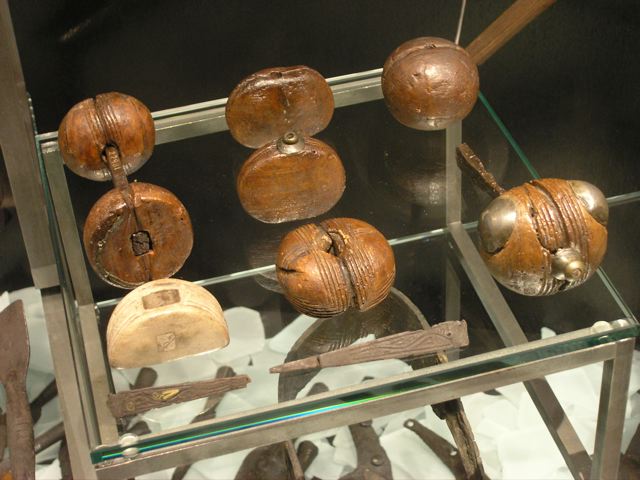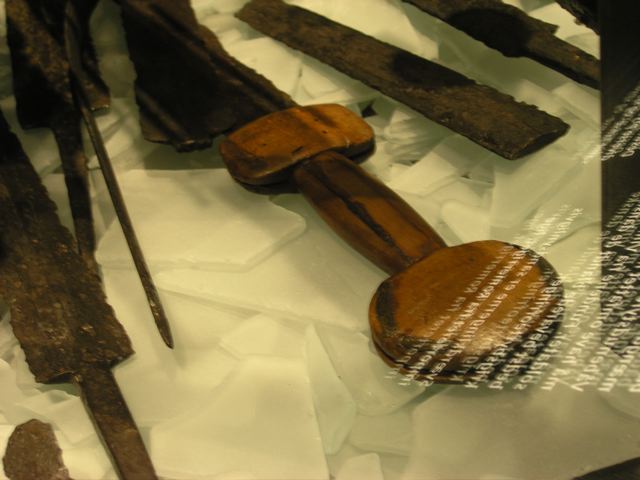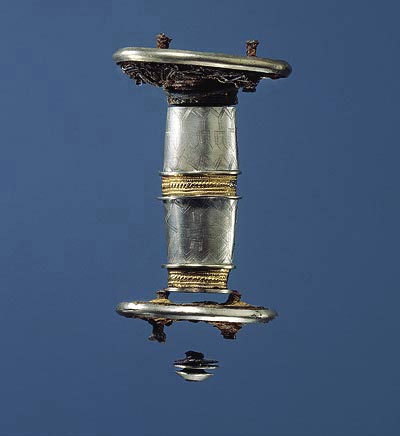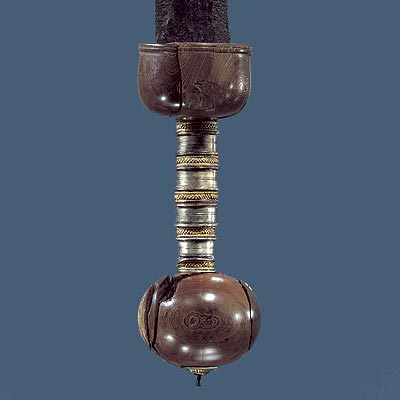& why? Due to new technology (perhaps very thin leather or stronger glue)? Or was it fashion, or...?
I did find a thread that stated none known on roman swords (though I was hoping not to hear that):
http://www.myArmoury.com/talk/viewtopic.php?t=13151
Another on seax said leather on grip (also decorations, not just plain wood) was reasonable perhaps at least as far back as 6th century:
http://www.myArmoury.com/talk/viewtopic.php?t=11894
Thanks to all.
Interesting question. I would think that since most grip materials usually aren't preserved it would be hard to have a definitive answer on this. There may be a single find with enough surviving material to suggest that leather was used as early as .... century. It's harder to say that something definitely didn't exist just because there is not a surviving example.
| Carl W. wrote: |
| & why? Due to new technology (perhaps very thin leather or stronger glue)? Or was it fashion, or...? |
http://1501bc.com/page/Umha_Aois_2008/Nationa...190135.jpg
Though it could be textile as well. This is the only bronze age sword though from Europe that seems to have the bronze hilt wrapped with something. All others, particularly of this type have highly decorated metal hilts, which were obviously not intended to be covered by leather or other wrapping.
Thanks Nathan & Jeroen. Gives me a fig leaf to take a little "could have happened" license, see how it looks. I am gradually convincing myself I want to buy a blade & try to make the rest myself, starting small (roman). myArmoury members that tweak & make appear to learn a lot & have fun.
Jeroen - spectacular museum & pics, thank you Very much for the link (& photos if yours).
Carl
Jeroen - spectacular museum & pics, thank you Very much for the link (& photos if yours).
Carl
I just found this thread, which shows a photo from Latvia museum, of a "very old axe" wrapped with leather.
http://www.myArmoury.com/talk/viewtopic.php?t...ght=mammen
Putting it here in case it might push back the 'leather age' (for handle wraps), though it looks like a coarse wrap compared to thin & tight sword wraps.
Anyway, if anyone runs across museum / archaeological evidence of ancient leather wrap usage, I'd be interested. Thanks.
http://www.myArmoury.com/talk/viewtopic.php?t...ght=mammen
Putting it here in case it might push back the 'leather age' (for handle wraps), though it looks like a coarse wrap compared to thin & tight sword wraps.
Anyway, if anyone runs across museum / archaeological evidence of ancient leather wrap usage, I'd be interested. Thanks.
| Nathan Keysor wrote: |
| I would think that since most grip materials usually aren't preserved it would be hard to have a definitive answer on this. |
Excellent point. Once again we are straying into the domain of "absence of evidence".
| Douglas S wrote: |
| Excellent point. Once again we are straying into the domain of "absence of evidence". |
True when it gets to this stage we can go by logic but I wont side with logic unless there is some sort of engraving
or metion in an ancient text that lends support to the argument presented by logic
I figure it probably goes back to the stone age. After all, if Native American Indians can work leather with only flint knives, then there's no reason to not assume that other stone age people did also. Of course assumptions don't mean anything in science till you get some evidence to back it up...which probably won't happen. So again, it's anyone's guess when leather grips were first used. ;-)
Yeah we do know that stone age man did use leather fro clothing and jewlery but unfortunatly such artifacts are very rare
as they degrade too easily logically it would make sence to use leather or some form of fabric to make a grip it helps you keep control of the weapon and stops the handle from hurting your hand but untill any early examples of swords using wrapping on the handels are found we can only speculate
as they degrade too easily logically it would make sence to use leather or some form of fabric to make a grip it helps you keep control of the weapon and stops the handle from hurting your hand but untill any early examples of swords using wrapping on the handels are found we can only speculate
The "when" is impossible to answer, there simply aren't enough surviving grips.
But it would be interesting to know which find is the oldest...
Regarding the "why":
In my opinion, as an archaeologist, the main reason behind that would be fashion. The technology, leatherwise, was there since the stone-age.
Beside the fashion there may as well be technological and economic reasons to wrap the grip of a blade in leather. This is certainly worthy of further investigation.
Greetings from Kiel (Germany)
But it would be interesting to know which find is the oldest...
Regarding the "why":
In my opinion, as an archaeologist, the main reason behind that would be fashion. The technology, leatherwise, was there since the stone-age.
Beside the fashion there may as well be technological and economic reasons to wrap the grip of a blade in leather. This is certainly worthy of further investigation.
Greetings from Kiel (Germany)
don't know if it's historical but once the leather of my reanactmentblade came loose, and under it was a wooden frame that formed the base for the grip
could it be that the leather was there to protect that wooden frame? because the bastard sword grip and such could more easily get hit by an oponent than a roman sword grip?
could it be that the leather was there to protect that wooden frame? because the bastard sword grip and such could more easily get hit by an oponent than a roman sword grip?
Though there's nothing to back it up, Some kind of covering for the wooden core could have been used from the earliest times, as it would add greatly to the strength of the wood undernath.
The easiest and most logical, would be leather binding or whipping with cord of some kind.
Some wooden grips have ferruls at both ends, and this also would serve, but without Something, wood can split or shatter with the shock of using a cutting weapon.
.
.....Just a thought.
Richard.
The easiest and most logical, would be leather binding or whipping with cord of some kind.
Some wooden grips have ferruls at both ends, and this also would serve, but without Something, wood can split or shatter with the shock of using a cutting weapon.
.
.....Just a thought.
Richard.
| Darren Tully wrote: |
| Yeah we do know that stone age man did use leather fro clothing and jewlery but unfortunatly such artifacts are very rare
as they degrade too easily logically it would make sence to use leather or some form of fabric to make a grip it helps you keep control of the weapon and stops the handle from hurting your hand but untill any early examples of swords using wrapping on the handels are found we can only speculate |
| Richard Hare wrote: |
| Though there's nothing to back it up, Some kind of covering for the wooden core could have been used from the earliest times, as it would add greatly to the strength of the wood undernath.
The easiest and most logical, would be leather binding or whipping with cord of some kind. Some wooden grips have ferruls at both ends, and this also would serve, but without Something, wood can split or shatter with the shock of using a cutting weapon. . .....Just a thought. Richard. |
Up until the early iron age, the hilts were assembled in a different way. When organic hilts were used, they generally used scales riveted onto a full tang. So that's not an issue in most bronze age and early iron age weapons.
The earliest frequent use of leather or textile wrapped grips that I know is from the Viking period. These held together multipiece wooden cores over the tang (front and back cover, with filling strips on the sides). So there it makes sense construction wise, as the wrapping holds the grip together. Before that, grips were generally build in a different manner, f.e. bone or horn grips with finger impressions cut out, which also don't quite lend themselves to being wrapped.
Another issue with leather wrapped grips is of course also the appearance. If not done properly, it really looks ugly. As the hilts were the most visible part of the sword, as that always sticks out of the scabbard when worn, the hilts were highly important in expressing status, culture etc. So looks were definately vital. Even if it would work well, but it looks ugly then it's not a favorite option.
I have a strong suspicion that many of the wooden hilts mounted on roman blades found in the danish bog finds were originally covered with leather.
I am talking about those hilts that are in "roman fashion" but probably made locally. They have spherical/semispherical pommel & guard, or indeed flat pommel and guard.
Always they have a deep grove in the plane of the edge cut into the wood, some 4-5 mm deep and 2-3 mm wide. Flanking this grove is often several parallel lines. My impression is that this was to fasten a glued leather covering, binding down the leather as the glue cured. Often you also find domed tacks with heads of silver decorating the surface. These would also be perfect to keep the leather down.
The flat pommels and guards often have tacks or even thin strips of sheet iron like commas just inside the edge. To me that is something that cannot easily be explained as anything else than a constructional element. It would be well suited to hold down leather.
On the blade side of some domed guards you also find these semi circular strips of iron, just inside the edge, like they were tacked down to hold a folded over edge of leather.
No hints remain as to how the grips were finished, but I suspect that the grips had leather cover too.
In those cases where you find grips made of silver sheet metal, there are often elements that look like they mimic cord and leather work.
 Attachment: 56.97 KB
Attachment: 56.97 KB

 Attachment: 45.19 KB
Attachment: 45.19 KB

 Attachment: 14.41 KB
Attachment: 14.41 KB

 Attachment: 13.15 KB
Attachment: 13.15 KB

I am talking about those hilts that are in "roman fashion" but probably made locally. They have spherical/semispherical pommel & guard, or indeed flat pommel and guard.
Always they have a deep grove in the plane of the edge cut into the wood, some 4-5 mm deep and 2-3 mm wide. Flanking this grove is often several parallel lines. My impression is that this was to fasten a glued leather covering, binding down the leather as the glue cured. Often you also find domed tacks with heads of silver decorating the surface. These would also be perfect to keep the leather down.
The flat pommels and guards often have tacks or even thin strips of sheet iron like commas just inside the edge. To me that is something that cannot easily be explained as anything else than a constructional element. It would be well suited to hold down leather.
On the blade side of some domed guards you also find these semi circular strips of iron, just inside the edge, like they were tacked down to hold a folded over edge of leather.
No hints remain as to how the grips were finished, but I suspect that the grips had leather cover too.
In those cases where you find grips made of silver sheet metal, there are often elements that look like they mimic cord and leather work.




Intresting thread. Its a pity many examples didnt survive. speaking of wraps, Im about to re wrap a sword for the first time, What sort of thickness should I be looking at?
Hi Tony, 2 oz. max, 1oz. or 1/2 oz. works the best for wrapping grips.
| Michael Pikula wrote: |
| Hi Tony, 2 oz. max, 1oz. or 1/2 oz. works the best for wrapping grips. |
oz? Um.. did you mean mm?
I am not sure on what the thickness is in mm, I could try to put a micrometer on a piece but it will be hard to say since it is easy to compress... Perhaps someone in Europe can give you a better idea/what units are used. Generally though you want to get the thinnest leather you can since it will be much easier to work, turn out smoother, and make the seam less noticeable.
the oz weight designation is roughly what 1 yard of the material weighs. Each ounce corresponds to roughly 1/64" (0.39 mm) thickness, although, density varies. 2.5 (usually given as 2 to 3 ounce approximate) is a reasonable approximation of 1 mm thick leather in fine quality skins. I would accept 2-4 ounce description as being o.k. if the vendor is reputable.
Page 1 of 2
You cannot post new topics in this forumYou cannot reply to topics in this forum
You cannot edit your posts in this forum
You cannot delete your posts in this forum
You cannot vote in polls in this forum
You cannot attach files in this forum
You can download files in this forum
All contents © Copyright 2003-2006 myArmoury.com — All rights reserved
Discussion forums powered by phpBB © The phpBB Group
Switch to the Full-featured Version of the forum
Discussion forums powered by phpBB © The phpBB Group
Switch to the Full-featured Version of the forum